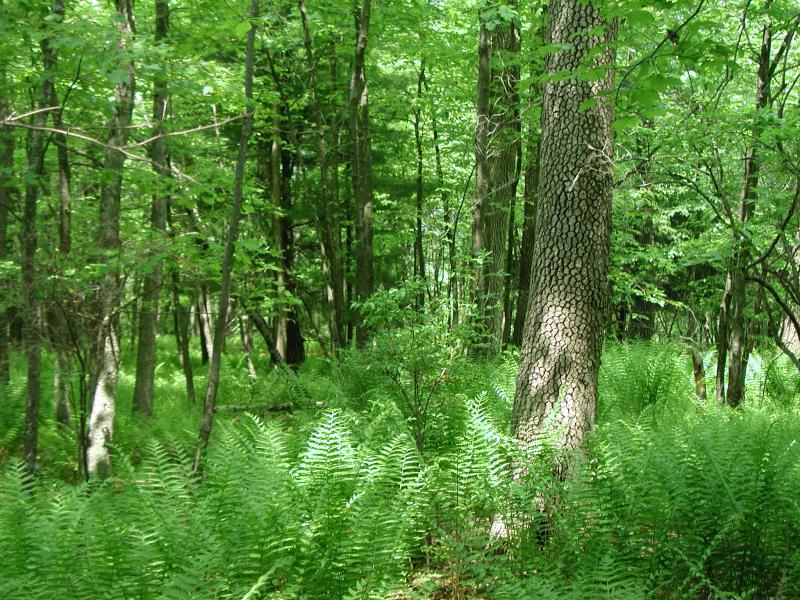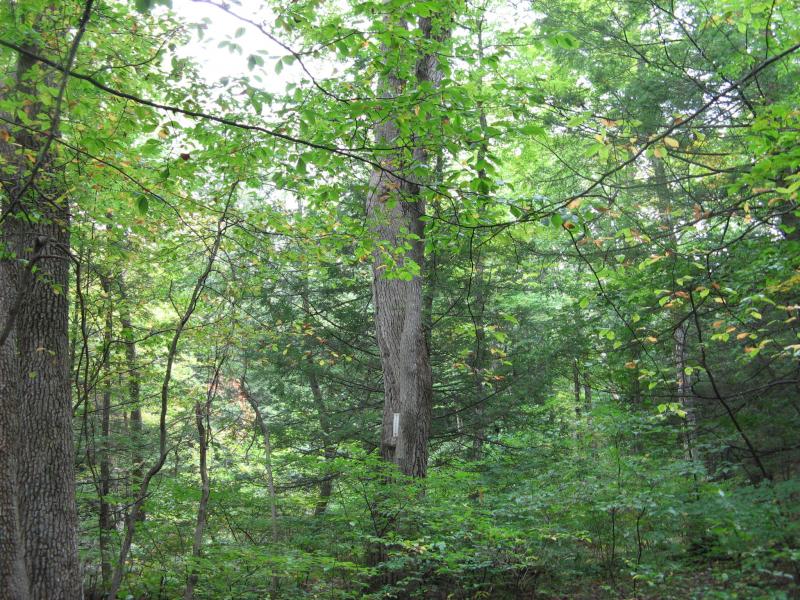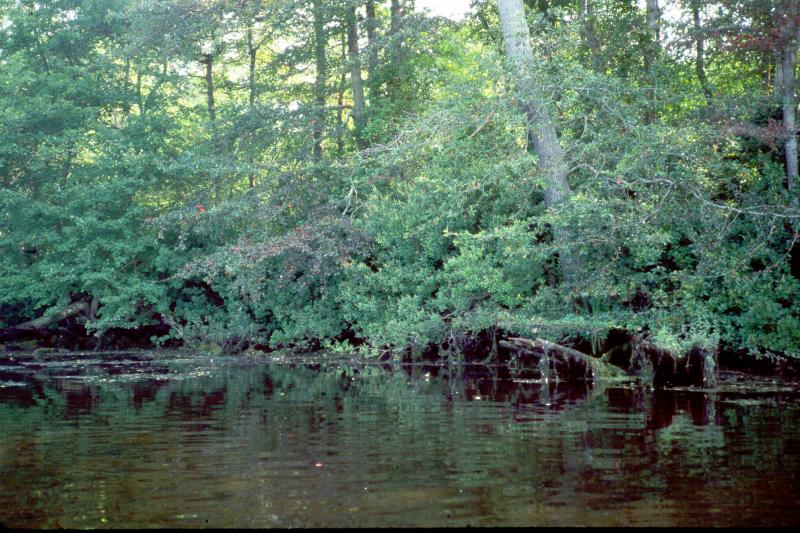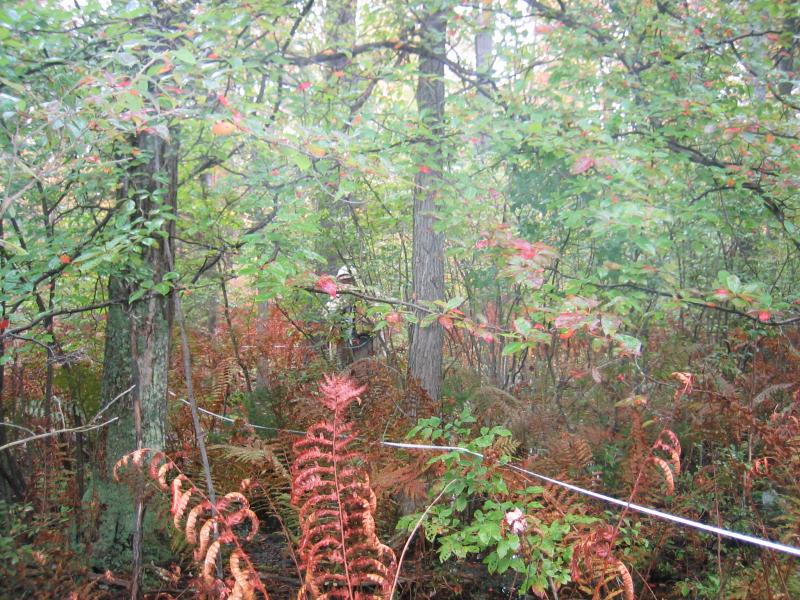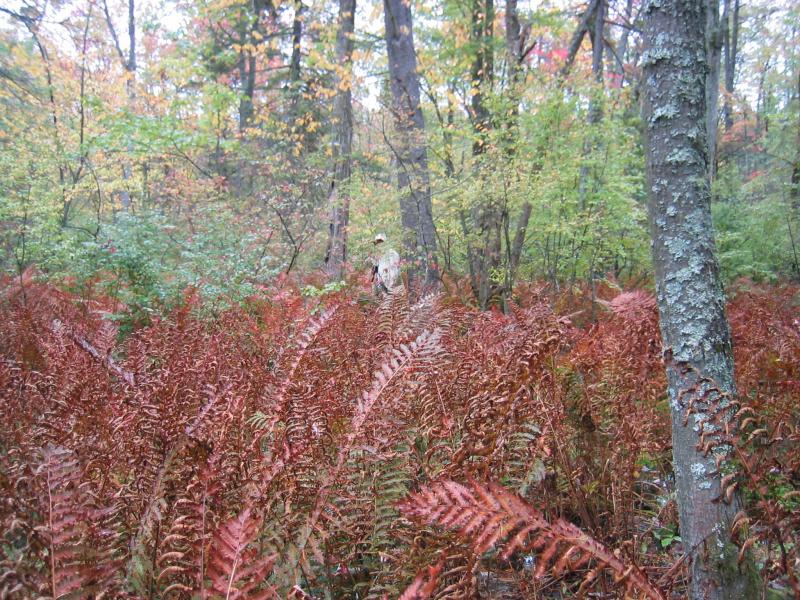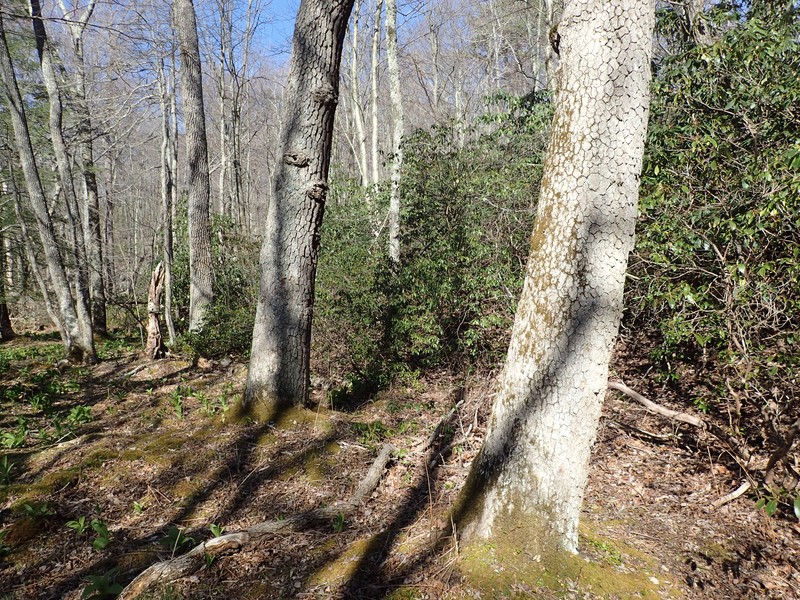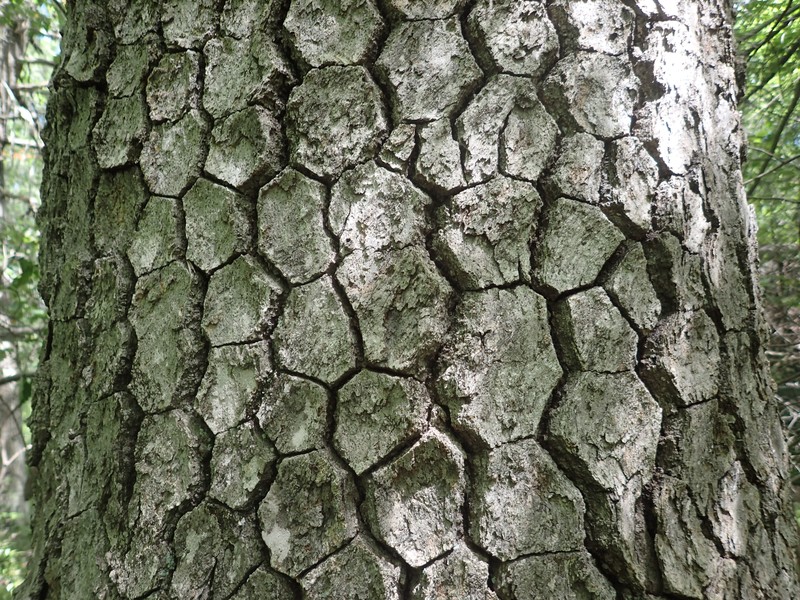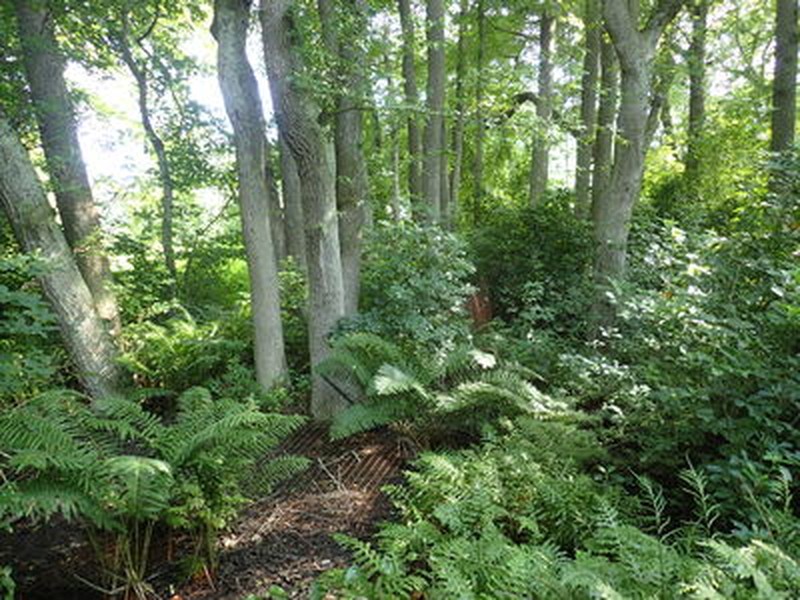Red Maple-Blackgum Swamp
- System
- Palustrine
- Subsystem
- Forested Mineral Soil Wetlands
- State Protection
- Not Listed
Not listed or protected by New York State.
- Federal Protection
- Not Listed
- State Conservation Status Rank
- S2
Imperiled in New York - Very vulnerable to disappearing from New York due to rarity or other factors; typically 6 to 20 populations or locations in New York, very few individuals, very restricted range, few remaining acres (or miles of stream), and/or steep declines.
- Global Conservation Status Rank
- G3G4
Vulnerable globally, or Apparently Secure - At moderate risk of extinction, with relatively few populations or locations in the world, few individuals, and/or restricted range; or uncommon but not rare globally; may be rare in some parts of its range; possibly some cause for long-term concern due to declines or other factors. More information is needed to assign either G3 or G4.
Summary
Did you know?
Ever wonder how tupelo honey received its name? Tupelo honey is a special type of light golden honey that never granulates. It is produced by using bees to pollinate the blackgum tree (Nyssa sylvatica), also called tupelo, by applying an unusual method. Bees are placed on elevated platforms in swamps during April and May. They travel only to the nearby blackgum blossoms, pollinate the trees, and return to the hive to produce tupelo honey.
State Ranking Justification
There are an estimated 20 to 30 extant occurrences statewide. A few documented occurrences have good viability and few are protected on public land or private conservation land. This community has a somewhat limited statewide distribution that is primarily concentrated on the coastal plain where there are several small, good quality examples. The current trend of this community is probably stable for occurrences on public land, or declining slightly elsewhere due to moderate threats that include alteration of the natural hydrology and introduction of invasive species.
Short-term Trends
The number and acreage of red maple-blackgum swamps in New York have probably declined slightly, or remained stable, in recent decades as a result of wetland protection regulations. Since World War II, urbanization has emerged as the predominant force impacting wetlands in most parts of the region (Golet et al. 1993).
Long-term Trends
The number and acreage of red maple-blackgum swamps in New York have probably declined substantially from historical numbers likely correlated with agricultural and other development. The principal causes of wetland loss in the Northeast prior to mid-1800s include conversion of wetlands to agriculture, the construction of impoundments for hydropower and water supply, and the cutting of swamp timber for lumber, fence posts, and fuel wood (Golet et al. 1993).
Conservation and Management
Threats
Red maple-blackgum swamps are threatened by development in the surrounding landscape and its assocaited run-off (e.g., residential and commercial development, mining, roads, bridges, utility ROWs, etc.), habitat alteration (e.g., excessive logging, filling, pollution), and recreational overuse (e.g., hiking, ATVs, trash dumping). Alteration to the natural hydrological regime is also a threat to this community (e.g., impoundments, blocked culverts, lowering water table). Deer over-browsing may be a threat at a few sites. Several red maple-blackgum swamps are threatened by invasive species, such as reedgrass (Phragmites australis ssp. australis ), multiflora rose (Rosa multiflora), Asiatic bittersweet (Celastrus orbiculatus), and Norway spruce (Picea abies). Conversion of wetlands for agriculture was a major cause of inland wetland loss in many areas of the Northeast historically, and it is still an important factor today, most notably in New York (Golet et al. 1993).
Conservation Strategies and Management Practices
Where practical, establish and maintain a natural wetland buffer to reduce storm-water, pollution, and nutrient run-off, while simultaneously capturing sediments before they reach the wetland. Buffer width should take into account the erodibility of the surrounding soils, slope steepness, and current land use. Wetlands protected under Article 24 are known as New York State "regulated" wetlands. The regulated area includes the wetlands themselves, as well as a protective buffer or "adjacent area" extending 100 feet landward of the wetland boundary (NYS DEC 1995). If possible, minimize the number and size of impervious surfaces in the surrounding landscape. Avoid habitat alteration within the wetland and surrounding landscape. For example, roads and trails should be routed around wetlands, and should not pass through the buffer area. If the wetland must be crossed, then bridges and boardwalks are preferred over filling. Restore past impacts, such as removing obsolete impoundments and ditches in order to restore the natural hydrology. Prevent the spread of invasive exotic species into the wetland through appropriate direct management, and by minimizing potential dispersal corridors, such as roads.
Development and Mitigation Considerations
When considering road construction and other development activities minimize actions that will change what water carries and how water travels to this community, both on the surface and underground. Water traveling over-the-ground as run-off usually carries an abundance of silt, clay, and other particulates during (and often after) a construction project. While still suspended in the water, these particulates make it difficult for aquatic animals to find food; after settling to the bottom of the wetland, these particulates bury small plants and animals and alter the natural functions of the community in many other ways. Thus, road construction and development activities near this community type should strive to minimize particulate-laden run-off into this community. Water traveling on the ground or seeping through the ground also carries dissolved minerals and chemicals. Road salt, for example, is becoming an increasing problem both to natural communities and as a contaminant in household wells. Fertilizers, detergents, and other chemicals that increase the nutrient levels in wetlands cause algal blooms and eventually an oxygen-depleted environment where few animals can live. Herbicides and pesticides often travel far from where they are applied and have lasting effects on the quality of the natural community. So, road construction and other development activities should strive to consider: 1. how water moves through the ground, 2. the types of dissolved substances these development activities may release, and 3. how to minimize the potential for these dissolved substances to reach this natural community.
Inventory Needs
Survey for occurrences statewide to advance documentation and classification of red maple-blackgum swamps. A statewide review of red maple-blackgum swamps is desirable. Continue searching for large sites in good condition (A- to AB-ranked).
Research Needs
Research composition of red maple-blackgum swamps statewide in order to characterize and describe inland and coastal plain variants. Collect sufficient plot data to support the recognition of at least two distinct red maple-blackgum swamp types based on composition and by ecoregion (e.g., "inland red maple-blackgum swamp" and "coastal plain red maple-blackgum swamp").
Rare Species
- Ardea herodias (Great Blue Heron) (guide)
- Botrychium oneidense (Blunt-lobed Grape Fern) (guide)
- Carex collinsii (Collins' Sedge) (guide)
- Carex mitchelliana (Mitchell's Sedge) (guide)
- Carex venusta (Dark-green Sedge) (guide)
- Chamaecyparis thyoides (Atlantic White Cedar) (guide)
- Chasmanthium laxum (Slender Spike Grass) (guide)
- Euonymus americanus (American Strawberry Bush) (guide)
- Magnolia virginiana (Sweetbay Magnolia) (guide)
- Neottia bifolia (Southern Twayblade) (guide)
- Pinus echinata (Short-leaved Pine) (guide)
- Platanthera ciliaris (Orange Fringed Orchid) (guide)
- Populus heterophylla (Swamp Cottonwood) (guide)
- Protonotaria citrea (Prothonotary Warbler) (guide)
- Sphenopholis pensylvanica (Swamp Oats) (guide)
- Stenanthium leimanthoides (Pine Barrens Death Camas) (guide)
- Uvularia puberula (Pine Barren Bellwort) (guide)
Range
New York State Distribution
This community is primarily located within the Long Island Lowland and Moraine subsection of the Mid-Atlantic Coastal Plain in Suffolk County, but a few inland examples are known from the Hudson Limestone Valley and the Eastern Adirondack Low Mountains. There may be a few additional sites of the inland variant of red maple-blackgum swamp scattered throughout upstate New York.
Global Distribution
Range is centered on the North Atlantic Coast and Lower New England/Northern Piedmont Ecoregions, and includes Connecticut, Massachusetts, New Hampshire, New Jersey, New York, Rhode Island.
Best Places to See
- Roosa Gap State Forest (Sullivan County)
- Caleb Smith State Park Preserve (Suffolk County)
- Heckscher State Park (Suffolk County)
- Wertheim National Wildlife Refuge (Suffolk County)
- Belmont Lake State Park (Suffolk County)
- Connetquot River State Park Preserve (Suffolk County)
Identification Comments
General Description
A hardwood swamp dominated by red maple (Acer rubrum) and blackgum (Nyssa sylvatica), that occurs in maritime, coastal, and inland areas, within poorly-drained depressions. The soil is typically made up of a thin layer of acidic, well-decomposed peat over sandy loam or loamy sand. The understory vegetation composition may vary between swamps on the coastal plain and those inland. For example, coastal plain swamps may include inkberry (Ilex glabra) and netted chain fern (Woodwardia areolata), whereas more northern, inland swamps may have mountain holly (Nemopanthus mucronatus) (Edinger et al. 2002).
Characters Most Useful for Identification
Red maple-blackgum swamps are poorly-drained depression wetlands featuring a canopy dominated by red maple and blackgum. Often there are hummock islands and hollows with standing water. The canopy can include low densities of other species such as swamp white oak (Quercus bicolor), red oak (Q. rubra), and black ash (Fraxinus nigra). The understory is moderate to dense with a well-developed shrub layer made up any of a variety of species such as highbush blueberry (Vaccinium corymbosum), winterberry (Ilex verticillata), sweet pepperbush (Clethra alnifolia), and swamp azalea (Rhododendron viscosum). Characteristic herbs include cinnamon fern (Osmunda cinnamomea), royal fern (O. regalis), skunk cabbage (Symplocarpus foetidus), and tussock sedge (Carex stricta).
Best Time to See
The community vegetation is at its peak during midsummer; at this time ferns, sedges, and herbs can be readily observed and identified. Striking seasonal leaf color can be enjoyed in the fall.
Red Maple-Blackgum Swamp Images
Classification
International Vegetation Classification Associations
This New York natural community encompasses all or part of the concept of the following International Vegetation Classification (IVC) natural community associations. These are often described at finer resolution than New York's natural communities. The IVC is developed and maintained by NatureServe.
- Red Maple - Blackgum - Yellow Birch / Peatmoss species Swamp Forest (CEGL006014)
- Red Maple / Swamp Azalea - Coastal Sweet-pepperbush Swamp Forest (CEGL006156)
NatureServe Ecological Systems
This New York natural community falls into the following ecological system(s). Ecological systems are often described at a coarser resolution than New York's natural communities and tend to represent clusters of associations found in similar environments. The ecological systems project is developed and maintained by NatureServe.
- Appalachian (Hemlock)-Northern Hardwood Forest (CES202.593)
- Laurentian-Acadian Pine-Hemlock-Hardwood Forest (CES201.563)
- North-Central Appalachian Acidic Swamp (CES202.604)
- Northeastern Interior Dry-Mesic Oak Forest (CES202.592)
Characteristic Species
-
Trees > 5m
- Acer rubrum var. rubrum (common red maple)
- Betula alleghaniensis (yellow birch)
- Carpinus caroliniana ssp. virginiana (musclewood, ironwood, American hornbeam)
- Fraxinus nigra (black ash)
- Fraxinus pennsylvanica (green ash)
- Nyssa sylvatica (black-gum, sour-gum)
- Tsuga canadensis (eastern hemlock)
-
Shrubs 2 - 5m
- Clethra alnifolia (coastal sweet-pepperbush)
- Ilex mucronata (mountain holly)
- Ilex verticillata (common winterberry)
- Toxicodendron vernix (poison-sumac)
- Vaccinium corymbosum (highbush blueberry)
- Viburnum dentatum var. lucidum (smooth arrowwood)
- Viburnum nudum var. cassinoides (northern wild-raisin)
-
Shrubs < 2m
- Clethra alnifolia (coastal sweet-pepperbush)
- Cornus amomum ssp. amomum (silky dogwood)
-
Vines
- Toxicodendron radicans ssp. radicans (eastern poison-ivy)
-
Herbs
- Bidens connata (purple-stemmed beggar-ticks)
- Calla palustris (wild calla)
- Carex comosa (bristly sedge)
- Carex stricta (tussock sedge)
- Impatiens capensis (spotted jewelweed, spotted touch-me-not)
- Lorinseria areolata (netted chain fern)
- Osmunda regalis var. spectabilis (royal fern)
- Osmundastrum cinnamomeum var. cinnamomeum (cinnamon fern)
-
Nonvascular plants
- Bazzania trilobata
- Calliergon spp.
- Sphagnum centrale
- Sphagnum fimbriatum
Similar Ecological Communities
- Hemlock-hardwood swamp
(guide)
Hemlock hardwood swamps have a high density of eastern hemlock (Tsuga canadensis) in the canopy. Blackgum may be in the canopy, but it is not a codominant.
- Perched swamp white oak swamp
(guide)
Perched swamp white oak swamps occur on hilltops, or on steps in slopes, over bedrock. Swamp white oak is a canopy dominant in this community, whereas it is present in relatively low densities in red maple-blackgum swamps.
- Red maple-hardwood swamp
(guide)
Red maple-hardwood swamps have a canopy composition that ranges from nearly pure red maple, to a variety of species; but blackgum, if present, is uncommon in the canopy. Blackgum is abundant and codominant in red maple-blackgum swamps.
- Red maple-swamp white oak swamp
(guide)
Red maple-swamp white oak swamps may have some blackgum, but it is not codominant. Red maple-blackgum swamps are usually permanently saturated compared to red maple-swamp white oak swamps that draw down in most years.
- Red maple-sweetgum swamp
(guide)
Red maple-sweetgum swamps have red maple and sweet gum (Liquidambar styraciflua) as canopy codominants. Blackgum may be present, but it occurs in low densities. Red maple-sweetgum swamps often occur on somewhat poorly-drained flats, rather than in basins.
- Silver maple-ash swamp
(guide)
Silver maple-ash swamps are dominated by silver maple (Acer saccharinum) and green ash (Acer pennsylvanica); blackgum is not typically abundant in this community.
Vegetation
Percent cover
This figure helps visualize the structure and "look" or "feel" of a typical Red Maple-Blackgum Swamp. Each bar represents the amount of "coverage" for all the species growing at that height. Because layers overlap (shrubs may grow under trees, for example), the shaded regions can add up to more than 100%.
Additional Resources
References
Breden, T.F., Y. Alger, K. Strakosch Walz, and A.G. Windisch. 2001. Classification of Vegetation Communities of New Jersey: Second Iteration. Association for Biodiversity Information and New Jersey Natural Heritage Program, Office of Natural Lands Management, Division of Parks and Forestry, NJ Department of Environmental Protection. Trenton, NJ.
Cain, S.A. and W.T. Penfound. 1938. Aceretum rubri: The red maple swamp forest of Central Long Island. Amer. Midland Naturalist 19:390-416.
Edinger, G. J., D. J. Evans, S. Gebauer, T. G. Howard, D. M. Hunt, and A. M. Olivero (editors). 2014. Ecological Communities of New York State. Second Edition. A revised and expanded edition of Carol Reschke’s Ecological Communities of New York State. New York Natural Heritage Program, New York State Department of Environmental Conservation, Albany, NY. https://www.nynhp.org/ecological-communities/
Edinger, Gregory J., D.J. Evans, Shane Gebauer, Timothy G. Howard, David M. Hunt, and Adele M. Olivero (editors). 2002. Ecological Communities of New York State. Second Edition. A revised and expanded edition of Carol Reschke's Ecological Communities of New York State. (Draft for review). New York Natural Heritage Program, New York State Department of Environmental Conservation. Albany, NY. 136 pp.
Fosberg, F.R. and T. Blunt. 1970. Vernon Black Gum Swamp. Rhodora 72:280-282.
Golet, F.C., A.J.K. Calhoun, W.R. DeRagon. D.J. Lowry, and A.J. Gold. 1993. Ecology of red maple swamps in the glaciated Northeast: A community profile. U.S. Fish and Wildlife Service Biological Services Program FWS/OBS-84/09.
Greller, Andrew M. 1977. A classification of mature forests on Long Island, New York. Bull. Torrey Bot. Club 140 (4):376-382.
Karpen, Daniel, B. Kershner, P. Kelly, David Hunt. 2004. Old Growth Black Tupelo on Long Island. The Quarterly Newsletter of the Long Island Botanical Society. 14(1):1-7.
McCormack, J. 1979. The vegetation of the New Jersey Pine Barrens. In Pine Barrens: Ecosystem and Landscape, Forman, R.T.T. (Ed.). Academic Press, New York, NY.
New York Natural Heritage Program. 2024. New York Natural Heritage Program Databases. Albany, NY.
New York Natural Heritage Program. New York State Department of Environmental Conservation. 625 Broadway, 5th floor. Albany, NY 12233-4757. (518) 402-8935.
New York State Department of Environmental Conservation. 1995. Freshwater Wetlands: Delineation Manual. July 1995. New York State Department of Environmental Conservation. Division of Fish, Wildlife, and Marine Resources. Bureau of Habitat. Albany, NY.
Reschke, Carol. 1990. Ecological communities of New York State. New York Natural Heritage Program, New York State Department of Environmental Conservation. Latham, NY. 96 pp. plus xi.
Sneddon, L., M. Anderson and K. Metzler. 1996. Community alliances and elements of the eastern region. Second draft. Unpublished report. The Nature Conservancy, Eastern Region Conservation Science, Boston, MA. April 11. 234 pp.
Sperduto, D. D., W. F. Nichols, K. F. Crowley, and D. A. Bechtel. 2000b. Black gum (Nyssa sylvatica Marsh) in New Hampshire. New Hampshire Natural Heritage Inventory, Concord, NH. 51 pp. plus appendices.
Vogelmann, H.W. 1976. An unusual Black Gum Swamp in Maine. Rhodora 78:326-327.
Links
About This Guide
This guide was authored by: Jennifer Garrett
Information for this guide was last updated on: May 16, 2024
Please cite this page as:
New York Natural Heritage Program. 2024.
Online Conservation Guide for
Red maple-blackgum swamp.
Available from: https://guides.nynhp.org/red-maple-blackgum-swamp/.
Accessed July 26, 2024.
